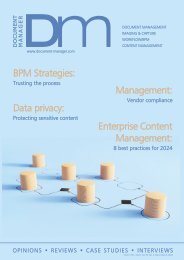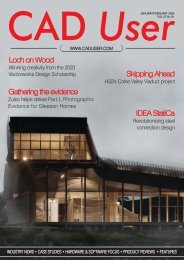CU Jul-Aug 2020
You also want an ePaper? Increase the reach of your titles
YUMPU automatically turns print PDFs into web optimized ePapers that Google loves.
INDUSTRY focus<br />
An interior shot in a modular landscape<br />
New house build using offsite components<br />
being overused. This not only results in<br />
poor productivity but also adds risks, as<br />
the management information used to<br />
make decisions is usually inaccurate, slow<br />
to produce and open to manipulation. C-<br />
level executives do not have robust<br />
oversight and governance. This affects<br />
everything from house sales, project<br />
management, project accounting, quantity<br />
surveying, and project cost control and<br />
planning, through to site management, risk<br />
management and aftercare.<br />
OFFSITE AND MODULAR<br />
CONSTRUCTION<br />
Many believe the solution to low<br />
productivity, the skills shortage and poor<br />
quality can only be solved by moving to an<br />
offsite and modular construction model.<br />
This means building homes, modules or<br />
components in a manufacturing facility and<br />
then shipping them to the construction site<br />
to be assembled. This trend is starting to<br />
gather pace and we are seeing many new<br />
modular and offsite manufacturing plants<br />
being built, with a number of organisations<br />
investing in the technology, These include<br />
government organisations such as local<br />
councils and housing associations and<br />
even finance companies like Legal &<br />
General, which has built a large modular<br />
homebuilding plant in the UK.<br />
Traditional contractors are also entering<br />
the modular housebuilding market, like<br />
Skanska which has formed BoKlok, a<br />
modular homebuilding business in<br />
partnership with IKEA. Amazon are<br />
developing Alexa-enabled prefabricated<br />
/modular homes, and some companies<br />
are experimenting with 3D printed houses.<br />
I believe these are key indicators of a<br />
revolution in the home building industry,<br />
and I expect to see further huge changes<br />
in the future, with offsite becoming one of<br />
the 'new normals' over the next 10 years.<br />
The geographical uptake in offsite and<br />
modular homes may still be in its infancy in<br />
most countries but a recent McKinsey<br />
report, 'Modular construction: from<br />
Projects to Products', highlights some<br />
international trends. The most advanced<br />
region is Scandinavia, where 45% of<br />
homes are built using offsite methods.<br />
Japan is 2nd with 15%, followed by<br />
Germany with 10%. After that comes China<br />
with 6%, UK 5%, Australia 5% and USA<br />
3%. Many countries therefore have a great<br />
opportunity for expansion in this area.<br />
Some traditional homebuilders have<br />
already anticipated this change and have<br />
invested and built new manufacturing<br />
plants. The McKinsey report also showed<br />
that 40 percent of homebuilders surveyed<br />
were already investing in manufacturing<br />
facilities or intended to in the near future.<br />
THE NEW TERMS OF REFERENCE<br />
Changing the way you build homes is not<br />
a simple transition for a traditional<br />
homebuilder. The new process starts at the<br />
design stage where a new house must be<br />
designed from day one to be built in a<br />
factory and assembled on site: Design for<br />
Manufacture and Assembly (DFMA).<br />
Designing is now based on a configuration<br />
of standard components with a greater<br />
focus on part numbers, bills of materials,<br />
kitting, inventory, shipping and logistics -<br />
and, of course, BIM integration etc.<br />
These are processes that traditional<br />
housebuilders don't usually follow, but we<br />
still have to execute projects using<br />
traditional construction techniques such<br />
as subcontract management, variations,<br />
retentions, etc. To be successful you<br />
need to become a hybrid business: an<br />
engineer-to-order manufacturer, a<br />
construction company and even a<br />
service business that offers an aftercare<br />
service to the homeowner. It does<br />
provide benefits, though: a lower cost<br />
(both build and maintenance costs)<br />
making houses more affordable, faster<br />
build times, Improved quality and safer<br />
construction. Housebuilders can also<br />
afford to focus on eco-friendly and<br />
energy efficient homes, and the labour<br />
shortage issue is largely resolved.<br />
The industry is changing. The new<br />
entrants already understand<br />
manufacturing, standardisation, logistics<br />
and assembly, and they are challenging<br />
the market to change and traditional<br />
housebuilders will have to learn how to<br />
work with them. Key to this is the adoption<br />
of new technology and modern ways of<br />
working such as BIM, robotics, 3D printing,<br />
offsite and modular manufacturing, AI and<br />
service management.<br />
MANAGING THE CHALLENGE<br />
Change will increase complexity with new<br />
technologies, processes and workflows<br />
rendering outdated systems even more<br />
inadequate and unsafe. Housebuilders will<br />
need to implement repeatable, consistent<br />
processes if they want to deliver projects at<br />
lower cost, in less time and to a higher<br />
quality. IFS offers a construction ERP<br />
solution that delivers a solid foundation for<br />
agile and flexible housebuilding businesses<br />
and can help to improve project delivery<br />
performance, productivity and margins with<br />
a single source of business truth to make<br />
accurate robust decisions.<br />
www.ifs.com/uk/<br />
<strong>Jul</strong>y/<strong>Aug</strong>ust <strong>2020</strong> 15

















